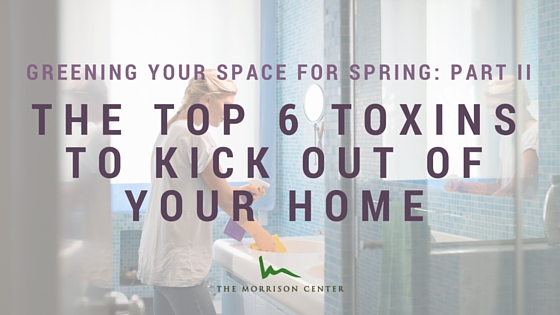The top six toxins to kick out of your home

Greening out your space has many different dimensions. We hope you enjoyed our previous piece about adding plants to clear the air around you, improve mood and focus, and stay healthy – and hopefully added a few featured plants around your home or office! Feeling inspired to go the next step?
A big part of “greening” your space includes reducing the contact you have with toxins. Surprisingly, many common household products have toxic ingredients that negatively affect health. The good news is swapping those products out for safer alternatives is a great way to “green your space!”
1. Teflon and Perfluorinated Chemicals (PFCs)
PFCs are used in non-stick surfaces, like Teflon, as well as stain- and water-resistant coatings on clothing, furniture and carpeting. The problem with these compounds is that they disrupt hormones in the body and they never biodegrade. Because these are “endocrine disruptors,” you certainly don’t want them in contact with your food. Plus, heating the surface sends PFC’s into the air, where they get inhaled.
Healthy Alternative: Instead of non-stick surfaces, choose cookware made from:
- Stainless steel (All-Clad)
- Ceramic enamel (Xtrema)
- Ceramic titanium (such as Scanpan)
- Cast-iron (Le Creuset)
2. Air Fresheners and Scented Candles
People usually think of scented candles, air fresheners and “purifiers” as “cleaning” the air of undesirable scents. However, the chemicals in air freshening products are actually polluting the air. They’re full of Volatile Organic Compounds (VOCs), such as pthalates, formaldehyde, benzene and other chemicals that are not included on labels – even those labeled “all natural.” In fact, one study detected 350 different chemicals and allergens from air fresheners. Scented candles may also be problematic, since candles with fragrance produce more soot, and burning paraffin produces harmful chemicals like toluene. Frequently inhaling these chemicals over time may increase the risk for cancer, asthma and allergies.
Healthy Solutions:
- Open windows and allow fresh air to ventilate a less than fresh room.
- Buying and displaying bunches of fresh or dried lavender or eucalyptus is a beautiful and natural way to scent a room.
- Finally, boiling cinnamon sticks in water on the stove is a great way to scent the air and cover any undesired kitchen smells.
- Yamuna Wellness Booster Essential Oil Spray
3. Dry Cleaning Chemicals
The process of dry cleaning uses chemicals called perchloroethylene, or perc, for short. Perc lingers on dry cleaned fabrics, including wool, cotton and polyester (but not silk) for up to a week. This suggests that the chemical, which is thought to be cancer-causing, vaporizes and is released into your home.
Healthy Solutions:
- The best way to avoid dry cleaning chemicals is to buy washable clothing.
- When dry cleaning is unavoidable, look for dry cleaners that use liquid carbon dioxide as part of a newer “wetcleaning” method.
- It’s also best to let dry-cleaned clothes “air out” outside, to avoid bringing perc chemicals into your home.
4. Fabric Softener and Dryer Sheets
Fabric softeners and dryer sheets work by coating your clothes in a layer of chemicals known to cause asthma and allergies. Plus, the fragrance in fabric softeners contain hundreds of untested chemicals, including toxic phthalates (see below).
Healthy Solutions:
- It’s easy to avoid this particular chemical exposure by simply skipping the dryer sheets or fabric softener. Half a cup of white vinegar during the rinse cycle softens fabrics naturally, and natural fibers don’t create much static in the dryer.
5. Plastics
Chemicals like Bisphenol A (BPA) and phthalates are used in making plastics to make them more pliable, but they also negatively impact hormones and disrupt our endocrine system. You’ll find them in plastic bottles, the lining of canned foods, shopping bags, plastic wrap and plastic food containers. Basically any time you’ve smelled something that’s got a “plastic-y” smell, you’ve just smelled plasticizers that have started to break down. The problem with these chemicals are that they can leach into food, drinks and anything edible that comes into contact with it. This is why it’s critically important to never pour hot liquids into or microwave anything in a plastic container, even if it says “microwave safe.”
Healthy Solutions:
- Choose glass, ceramic or stainless steel bottles and food storage containers as often as possible – bkr water bottles, glassware
- Don’t let plastic wrap come into contact with food you plan to eat.
6. Antibacterial and Triclosan
Triclosan is an antibacterial ingredient that can be found in liquid soap, deodorant, toothpaste, mouthwash, cosmetics and children’s toys, and is linked to immune system and endocrine system dysfunctions. Triclosan is chemically similar to dioxin, a potentially cancer causing chemical. It also reacts to the chlorine in tap water, creating chloroform gas, a toxic substance. Triclosan is typically labeled as an ingredient in household products, so it’s relatively easy to avoid.
Healthy Solutions:
- Choose soaps, toothpaste and mouthwash formulated without anti-bacterial ingredients, which is better for your “microbiome” anyway!
Want a healthy alternative to freshen your home that’s not only toxin-free, it may actually support your immune system? We love Yamuna’s Wellness Booster Spray. Yamuna’s expert blend of essential oils, including lavender, eucalyptus and peppermint, is wonderful for your home or office. Check it out on DailyBenefit.com.